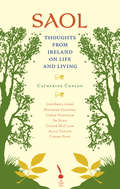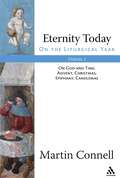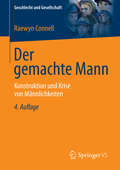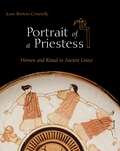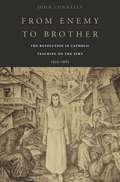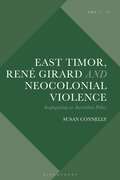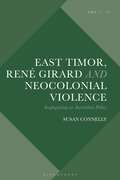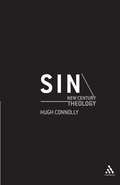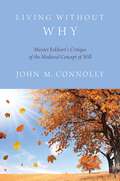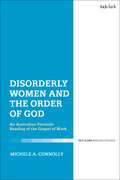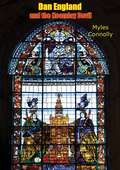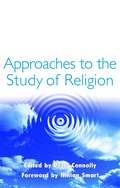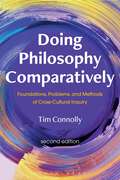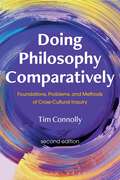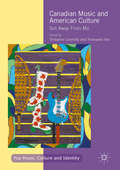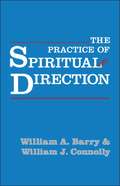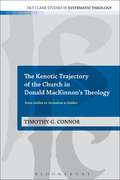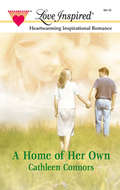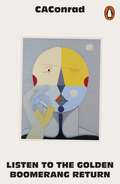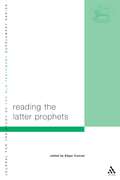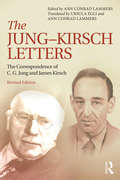- Table View
- List View
Saol: Thoughts from Ireland on Life & Living
by Catherine ConlonFrom the earliest times people have pondered why we are here; philosophers and scientists continue to grapple with the question. For this compilation of wisdom and insights into what is truly important, Catherine Conlon tracked down people from varying walks of life, all with a deep connection to Ireland, for answers to life’s crucial questions. Contributors include Maureen Gaffney, Chris Hadfield, Sr Stan, Colum McCann, Alice Taylor, Conor Pope and many others from the worlds of writing, politics, journalism, charity and more. This collection will inspire self-reflection and lead us to reconsider our notion of the real value of our lives.
Eternity Today, Vol. 1: On the Liturgical Year: On God and Time, Advent, Christmas, Epiphany, Candlemas
by Martin ConnellAccording to Dom Gregory Dix, the basic shape of the Christian liturgy has remained the same "ever since thirteen men met for supper in an upper room at Jerusalem" some two thousand years ago. According to Martin Connell, the same cannot be said for the liturgical year. The Triduum, or three days of Easter, only emerged in the fourth century. So, too, did Christmas. Earlier, Epiphany was the birthday of the Savior. Although a pre-Easter fast of variable length was observed since earliest times, the precise Forty Day span only appeared, once again, in the fourth century. And that foundational fourth century also saw the beginnings of the observance of Advent, which actually took centuries to catch on. As Connell demonstrates in this fascinating book, the varieties of Christian observance emerged in local communities stretching from Gaul to India and were often born in the struggles that were define orthodoxy and heresy.Eternity Today is a vade mecum for anyone who wishes to observe the liturgical year with intelligent devotion. Throughout, Connell aims to recover the theology and spirituality of the Christian year. As an aid to reflection, he incorporates numerous selections of contemporary poetry, thereby demonstrating how secular poets can often hit upon a point that finds its echo in Christian life and ritual.Eternity Today: The Liturgical Year, Volume 1 covers Advent, Christmas, Epiphany, Candlemas, and Ordinary Time.
Der gemachte Mann: Konstruktion und Krise von Männlichkeiten (Geschlecht und Gesellschaft #8)
by Raewyn ConnellMännlichkeit, so zeigt dieses überaus erfolgreiche Buch, ist eine gesellschaftlich konstruierte Kategorie, die längst nicht mehr eindeutig ist. Wie das soziale Geschlecht ,männlich‘ entstanden ist, und wie einzelne Männer mit der Vielfalt und den Krisen moderner Männlichkeiten umgehen, wird anschaulich geschildert. In zwei neuen Kapiteln beleuchtet die Autorin die bisherige Rezeption ihrer Arbeit zur „hegemonialen Männlichkeit“ und stellt Geschlechterverhältnisse in den Kontext einer Weltgesellschaft mit neoliberaler Prägung.
Portrait of a Priestess: Women and Ritual in Ancient Greece
by Joan Breton ConnellyIn this sumptuously illustrated book, Joan Breton Connelly gives us the first comprehensive cultural history of priestesses in the ancient Greek world. Connelly presents the fullest and most vivid picture yet of how priestesses lived and worked, from the most famous and sacred of them--the Delphic Oracle and the priestess of Athena Polias--to basket bearers and handmaidens. Along the way, she challenges long-held beliefs to show that priestesses played far more significant public roles in ancient Greece than previously acknowledged.Connelly builds this history through a pioneering examination of archaeological evidence in the broader context of literary sources, inscriptions, sculpture, and vase painting. Ranging from southern Italy to Asia Minor, and from the late Bronze Age to the fifth century A.D., she brings the priestesses to life--their social origins, how they progressed through many sacred roles on the path to priesthood, and even how they dressed. She sheds light on the rituals they performed, the political power they wielded, their systems of patronage and compensation, and how they were honored, including in death. Connelly shows that understanding the complexity of priestesses' lives requires us to look past the simple lines we draw today between public and private, sacred and secular.The remarkable picture that emerges reveals that women in religious office were not as secluded and marginalized as we have thought--that religious office was one arena in ancient Greece where women enjoyed privileges and authority comparable to that of men. Connelly concludes by examining women's roles in early Christianity, taking on the larger issue of the exclusion of women from the Christian priesthood. This paperback edition includes additional maps and a glossary for student use.
From Enemy to Brother: The Revolution In Catholic Teaching On The Jews, 1933-1965
by John ConnellyIn 1965 the Second Vatican Council declared that God loves the Jews. Yet the Church had taught for centuries that Jews were cursed by God, and had mostly kept silent as Jews were slaughtered by Nazis. How did an institution whose wisdom is said to be unchanging undertake one of the largest, yet most undiscussed, ideological swings in modern history?
From Enemy to Brother: The Revolution In Catholic Teaching On The Jews, 1933-1965
by John ConnellyIn 1965 the Second Vatican Council declared that God loves the Jews. Yet the Church had taught for centuries that Jews were cursed by God, and had mostly kept silent as Jews were slaughtered by Nazis. How did an institution whose wisdom is said to be unchanging undertake one of the largest, yet most undiscussed, ideological swings in modern history?
East Timor, René Girard and Neocolonial Violence: Scapegoating as Australian Policy (Violence, Desire, and the Sacred)
by Susan ConnellyIn a new historical interpretation of the relationship between Australia and East Timor, Susan Connelly draws on the mimetic theory of René Girard to show how the East Timorese people were scapegoated by Australian foreign policy during the 20th century.Charting key developments in East Timor's history and applying three aspects of Girard's framework – the scapegoat, texts of persecution and conversion – Connelly reveals Australia's mimetic dependence on Indonesia and other nations for security. She argues that Australia's complicity in the Indonesian invasion and occupation of East Timor perpetuated the sacrifice of the Timorese people as victims, thus calling into question the traditional Australian values of egalitarianism and fairness. Connelly also examines the embryonic conversion process apparent in levels of recognition of the innocent victim and of the Australian role in East Timor's suffering, as well as the consequent effects on Australian self-perception.Emphasising Girardian considerations of fear, suffering, forgiveness and conversion, this book offers a fresh perspective on Australian and Timorese relations that in turn sheds light on the origins and operations of human violence.
East Timor, René Girard and Neocolonial Violence: Scapegoating as Australian Policy (Violence, Desire, and the Sacred)
by Susan ConnellyIn a new historical interpretation of the relationship between Australia and East Timor, Susan Connelly draws on the mimetic theory of René Girard to show how the East Timorese people were scapegoated by Australian foreign policy during the 20th century.Charting key developments in East Timor's history and applying three aspects of Girard's framework – the scapegoat, texts of persecution and conversion – Connelly reveals Australia's mimetic dependence on Indonesia and other nations for security. She argues that Australia's complicity in the Indonesian invasion and occupation of East Timor perpetuated the sacrifice of the Timorese people as victims, thus calling into question the traditional Australian values of egalitarianism and fairness. Connelly also examines the embryonic conversion process apparent in levels of recognition of the innocent victim and of the Australian role in East Timor's suffering, as well as the consequent effects on Australian self-perception.Emphasising Girardian considerations of fear, suffering, forgiveness and conversion, this book offers a fresh perspective on Australian and Timorese relations that in turn sheds light on the origins and operations of human violence.
Sin (New Century Theology)
by Hugh ConnollyConnolly investigates the realities of sin through reflection on different biblical and literary texts. Writers as varied as Sophocles, Graham Greene, Gabriel Garcia Marquez and Irvine Welsh help illuminate different models of sin. Physical evil, law and morality, alienation and existence, power and money, spiritual love and failure are some of the ever-compelling themes that are scrutinized. In Dostoevsky's novels, sin is the rejection of life and love and a refusal to commit oneself to destiny. This book rediscovers a truly relational understanding of sin and moves toward a more adult conception of the mystery of sin and forgiveness.
Living Without Why: Meister Eckhart's Critique of the Medieval Concept of Will
by John M. ConnollyWhat does it mean to "live without why"? This was the advice of Meister Eckhart (ca. 1260-1328), both in his Latin treatises to philosophers and theologians and in his German sermons to nuns and ordinary lay persons. He seems to have meant that we should live and act out of justice or goodness and not in order to gain some reward for our deeds. This message was received with indignation by the Church hierarchy and was condemned by the Pope in 1329. How did Eckhart come to formulate it? And why was it so controversial? John M. Connolly addresses these questions by locating Eckhart's thinking about how to live within the mainstream synthesis of Christian and classical thought formulated in the High Middle Ages. He calls the classical Greek moral consensus "teleological eudaimonism," according to which correct living coincides with the attainment of happiness (eudaimonia). This involves living a life marked by the practice of the virtues, which in turn requires a consistent desire for the correct goal in life. This desire is the core notion of will. In late antiquity Augustine drew on this tradition in formulating his views about how Christians should live. This required grafting onto classical eudaimonism a set of distinctively scriptural notions such as divine providence, original sin, redemption, and grace. In the 13th century these ideas were systematized by Thomas Aquinas in his will-centered moral theology. Eckhart claimed that this tradition was profoundly mistaken. Far from being a wild-eyed mystic or visionary, he argued trenchantly from classical philosophical principles and the Christian scriptures. Connolly proposes that Eckhart's views, long obscured by the papal condemnation, deserve reconsideration today.
Disorderly Women and the Order of God: An Australian Feminist Reading of the Gospel of Mark
by Michele A. ConnollyMichele A. Connolly's postcolonial analysis links the Gospel of Mark - produced in the context of the Roman Empire - with contemporary Australia, established initially as a colony of the British Empire. Feminist analysis of texts from two foundational events in Australian colonial history reveal that women in such texts tend to be marginalised, silenced and denigrated. Connolly posits that imperialist sexism, both ancient and modern, perceives women as a threat to the order that males alone can impose on the world. The Gospel of Mark portrays Jesus bringing the order of the Reign of God to combat the disorder of apocalyptic evil. Jesus' task is a markedly male project, against which eleven female characters are portrayed as disorderly distractions who are managed by being marginalised, silenced and denigrated, contradicting Jesus' message of mutual service and non-domination. In his death under apocalyptic power, Jesus is likewise depicted as isolated, silenced and denigrated, subtly associating femininity with chaos, failure and disgrace.
Disorderly Women and the Order of God: An Australian Feminist Reading of the Gospel of Mark
by Michele A. ConnollyMichele A. Connolly's postcolonial analysis links the Gospel of Mark - produced in the context of the Roman Empire - with contemporary Australia, established initially as a colony of the British Empire. Feminist analysis of texts from two foundational events in Australian colonial history reveal that women in such texts tend to be marginalised, silenced and denigrated. Connolly posits that imperialist sexism, both ancient and modern, perceives women as a threat to the order that males alone can impose on the world. The Gospel of Mark portrays Jesus bringing the order of the Reign of God to combat the disorder of apocalyptic evil. Jesus' task is a markedly male project, against which eleven female characters are portrayed as disorderly distractions who are managed by being marginalised, silenced and denigrated, contradicting Jesus' message of mutual service and non-domination. In his death under apocalyptic power, Jesus is likewise depicted as isolated, silenced and denigrated, subtly associating femininity with chaos, failure and disgrace.
Dan England and the Noonday Devil
by Myles ConnollyA joyous gent who sings of the glory of the true realities of life, Dan England chose “talking” as his vocation in life. This he did, joyously and beautifully. He talked to the poets without dreams, actors who couldn’t act, and writers who couldn’t write who came to his house for an evening to listen and stayed on for months…years.Not a few found new hope as they heard him capture the poetry of living in his talk of saints, and in stories about his greatness of God’s gifts (among which was the wine that gave added sparkle to his words). There was Briggs, the religion editor without religion to become a fearless “defender of the faith” under Dan’s influence. And Tim, the janitor who “exposed” the corruption of the Match Industry when in an idle hour’s count of a box of matches he found “four” missing. For the glorious length of a Dan England discourse the retiring little janitor became a tiger for reform.This is the latest troubadour of life-beautiful to come from the pen of the author of the classic Mr. Blue.
Approaches to the Study of Religion
by Peter ConnollyIt has been argued that religious studies is a polymethodic discipline, and that the student of religion should be familiar with the approaches of the major disciplines concerned with understanding the nature of religion, not least because the approach adopted has profound influence on the phenomena chose for investigation and the conclusions reached.This book is the first textbook, specifically designed for undergraduate students, that provides the essential background on methods of the major relevant disciplines.Presenting each of the significant approaches to religion in an informed manner, the book brings together experienced researchers from feminism, anthropology, sociology, phenomenology, psychology, philosophy, and theology. It presents a consistent approach throughout, with each chapter dealing with the same themes: the historical development of the approach, the characteristics of the approach, and the surrounding issues and debates.
Doing Philosophy Comparatively: Foundations, Problems, and Methods of Cross-Cultural Inquiry
by Tim ConnollyWhat standards should we use to evaluate culturally distinct philosophies? What kind of barrier does language or cultural difference pose in our attempts to understand other traditions? How do we avoid our comparisons being biased? Doing Philosophy Comparatively answers these questions by providing a thorough overview of the methodology involved in extending philosophy across linguistic and cultural boundaries. Now revised and updated to showcase the most recent developments in the field, this second edition engages with philosophies beyond the Anglo-European tradition and features: · Examples of cross-cultural philosophy from a wider range of non-Western traditions · Methodological innovations from works of comparative philosophy published in the last decade · Focused exercises for each chapter demonstrating how to interact meaningfully with primary texts and engage with recent debates in comparative philosophy · Updated discussion questions and readings Introducing the main problems, methods, and approaches of comparative philosophy, this new edition shows you how to make informed cross-cultural judgments through reflection and practice. It remains an essential toolkit for the practice of doing comparative philosophy.
Doing Philosophy Comparatively: Foundations, Problems, and Methods of Cross-Cultural Inquiry
by Tim ConnollyWhat standards should we use to evaluate culturally distinct philosophies? What kind of barrier does language or cultural difference pose in our attempts to understand other traditions? How do we avoid our comparisons being biased? Doing Philosophy Comparatively answers these questions by providing a thorough overview of the methodology involved in extending philosophy across linguistic and cultural boundaries. Now revised and updated to showcase the most recent developments in the field, this second edition engages with philosophies beyond the Anglo-European tradition and features: · Examples of cross-cultural philosophy from a wider range of non-Western traditions · Methodological innovations from works of comparative philosophy published in the last decade · Focused exercises for each chapter demonstrating how to interact meaningfully with primary texts and engage with recent debates in comparative philosophy · Updated discussion questions and readings Introducing the main problems, methods, and approaches of comparative philosophy, this new edition shows you how to make informed cross-cultural judgments through reflection and practice. It remains an essential toolkit for the practice of doing comparative philosophy.
Canadian Music and American Culture: Get Away From Me
by Tristanne Connolly Tomoyuki IinoThis collection explores Canadian music’s commentaries on American culture. ‘American Woman, get away from me!’ - one of the most resonant musical statements to come out of Canada - is a cry of love and hate for its neighbour. Canada’s close, inescapable entanglement with the superpower to the south provides a unique yet representative case study of the benefits and detriments of the global American culture machine. Literature scholars apply textual and cultural analysis to a selection of Anglo-Canadian music – from Joni Mitchell to Peaches, via such artists as Neil Young, Rush, and the Tragically Hip – to explore the generic borrowings and social criticism, the desires and failures of Canada’s musical relationship with the USA. This innovative volume will appeal to those interested in Music, Canadian Studies, and American Studies.
Canadian Music and American Culture: Get Away From Me
by Tristanne Connolly Tomoyuki IinoThis collection explores Canadian music’s commentaries on American culture. ‘American Woman, get away from me!’ - one of the most resonant musical statements to come out of Canada - is a cry of love and hate for its neighbour. Canada’s close, inescapable entanglement with the superpower to the south provides a unique yet representative case study of the benefits and detriments of the global American culture machine. Literature scholars apply textual and cultural analysis to a selection of Anglo-Canadian music – from Joni Mitchell to Peaches, via such artists as Neil Young, Rush, and the Tragically Hip – to explore the generic borrowings and social criticism, the desires and failures of Canada’s musical relationship with the USA. This innovative volume will appeal to those interested in Music, Canadian Studies, and American Studies.
Practice Of Spiritual Direction
by William ConnollyThe classic work on helping people become closer to God. Fathers Barry and Connolly see the work of spiritual direction as helping people to develop their relationship with God. In thinking and practice they have absorbed the insights of modern psychotherapy, but have not been absorbed by them. This highly practical book reflects the authors' experience at the Center for Religious Development in Cambridge, Massachusetts, where spiritual direction is available and where directors are trained.
The Kenotic Trajectory of the Church in Donald MacKinnon's Theology: From Galilee to Jerusalem to Galilee (T&T Clark Studies in Systematic Theology)
by Timothy G. ConnorThe book explores those aspects of Donald MacKinnon's theological writings which challenge the claim of the liberal Catholic tradition in the Church of England to have forged an ecclesiological consensus, namely that the Church is the extension of the incarnation. MacKinnon destabilized this claim by exposing the wide gulf between theory and practice in that church, especially in his own Anglo-Catholic tradition within it. For him the collapse of Christendom is the occasion for a dialectical reconstruction of the relation of the Church to Jesus Christ and to the world on the basis of the gospel. His basic claim is that authentic ecclesial existence must correspond with what was revealed and effected by Jesus along his way from Galilee to Jerusalem to Galilee. Reflection on the Church thus takes the form of a lived response shaped by a Christocentric grammar of faith: the submission of the church to Jesus' contemporaneous interrogation, a sustained attentiveness to him and the willing embrace of his 'hour'.
A Home Of Her Own (Mills And Boon Love Inspired Ser. #No. 167)
by Cathleen ConnorsTHE PRODIGAL DAUGHTER No matter how far she roamed, Melodie Coleman had never quite shaken the dust of her Wyoming hometown–nor the bittersweet memories. Now, widowed and pregnant, she was back in high country for her mother' s funeral. Back to face a charismatic cowboy–and the truth about why she shattered his heart so long ago…
Listen to the Golden Boomerang Return
by CA ConradThe new collection from 'one of America's most legendary living poets' (Ocean Vuong), written in the drive to fall in love with the world again not as it was, but as it iswhen the hammerapproached we thought is that thing coming this wayBreathing, moving, living on the page, CAConrad’s exhilarating work is centred on the (Soma)tic ritual, their celebrated practice which draws on nature, crystals, meditation and interactions with strangers to create an ‘extreme present’ of unfettered creativity from which poems can emerge.Listen to the Golden Boomerang Return gathers the results of a single new ritual, focused on fellow animals who have found ways to thrive in the Anthropocene, and spanning environments from Seattle – a city built in the midst of an abundant nontropical rainforest – to the Mojave Desert. The poet receives gifts from a crow; associates different parts of their body with nine different species encountered in the desert; and joins a woman each morning in feeding rats in the streets of Rome, taking turns looking out for the police.Written with urgency, hope, anger and joy, the poems that result are an ode to survival in a world that humanity has poisoned, and a testament to a love that knows no by-laws.
Reading the Latter Prophets: Toward a New Canonical Criticism (The Library of Hebrew Bible/Old Testament Studies)
by Edgar W. ConradEdgar W. Conrad focuses on the prophetic books as composite collections and shows that (1) prophets are characters in the text, depicted as figures of the past whose words are significant for a later time; (2) reading and writing play a central role in the depiction of prophets; (3) prophetic books are presented as written words available to later generations through reading; (4) that read as a whole, the latter prophets depict the end of prophecy and the emergence of messengers of the Lord.Reading the Latter Prophets is an important contribution to the problems of both the formation and function of the prophetic literature.
The Jung-Kirsch Letters: The Correspondence of C.G. Jung and James Kirsch
by Ann Conrad LammersThis book charts Carl Gustav Jung’s 33-year (1928-61) correspondence with James Kirsch, adding depth and complexity to the previously published record of the early Jungian movement. Kirsch was a German-Jewish psychiatrist, a first-generation follower of Jung, who founded Jungian communities in Berlin, Tel Aviv, London, and Los Angeles. Their letters tell of heroic survival, brilliant creativity, and the building of generative institutions, but these themes are darkened by personal and collective shadows. The Nazi era looms over the first half of the book, shaping the story in ways that were fateful not only for Kirsch and his career but also for Jung and his. Kirsch trained with Jung and acted as a tutor in Jewish psychology and culture to him. In 1934, fearing that anti-Semitism had seized his teacher, Kirsch challenged Jung to explain some of his publications for the Nazi-dominated Medical Society for Psychotherapy. Jung’s answer convinced Kirsch of his sincerity, and from then on Kirsch defended him fiercely against any allegation of anti-Semitism. We also witness Kirsch’s lifelong struggle with states of archetypal possession: his identification with the interior God-image on the one hand, and with unconscious feminine aspects of his psyche on the other. These complexes were expressed, for Kirsch, in physical symptoms and emotional dilemmas, and they led him into clinical boundary violations which were costly to his analysands, his family and himself. The text of these historical documents is translated with great attention to style and accuracy, and generous editorial scaffolding gives glimpses into the writers’ world. Four appendices are included: two essays by Kirsch, a series of letters between Hilde Kirsch and Jung, and a brief, incisive essay on the Medical Society for Psychotherapy. This revised edition includes primary material that was unavailable when the book was first published, as well as updated footnotes and minor corrections to the translated letters.
The Jung-Kirsch Letters: The Correspondence of C.G. Jung and James Kirsch
by Ann Conrad LammersThis book charts Carl Gustav Jung’s 33-year (1928-61) correspondence with James Kirsch, adding depth and complexity to the previously published record of the early Jungian movement. Kirsch was a German-Jewish psychiatrist, a first-generation follower of Jung, who founded Jungian communities in Berlin, Tel Aviv, London, and Los Angeles. Their letters tell of heroic survival, brilliant creativity, and the building of generative institutions, but these themes are darkened by personal and collective shadows. The Nazi era looms over the first half of the book, shaping the story in ways that were fateful not only for Kirsch and his career but also for Jung and his. Kirsch trained with Jung and acted as a tutor in Jewish psychology and culture to him. In 1934, fearing that anti-Semitism had seized his teacher, Kirsch challenged Jung to explain some of his publications for the Nazi-dominated Medical Society for Psychotherapy. Jung’s answer convinced Kirsch of his sincerity, and from then on Kirsch defended him fiercely against any allegation of anti-Semitism. We also witness Kirsch’s lifelong struggle with states of archetypal possession: his identification with the interior God-image on the one hand, and with unconscious feminine aspects of his psyche on the other. These complexes were expressed, for Kirsch, in physical symptoms and emotional dilemmas, and they led him into clinical boundary violations which were costly to his analysands, his family and himself. The text of these historical documents is translated with great attention to style and accuracy, and generous editorial scaffolding gives glimpses into the writers’ world. Four appendices are included: two essays by Kirsch, a series of letters between Hilde Kirsch and Jung, and a brief, incisive essay on the Medical Society for Psychotherapy. This revised edition includes primary material that was unavailable when the book was first published, as well as updated footnotes and minor corrections to the translated letters.
